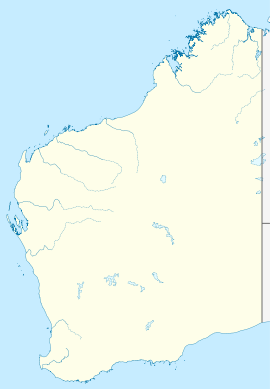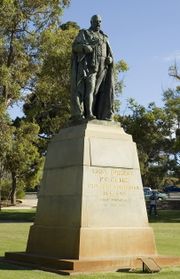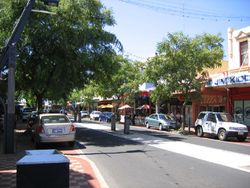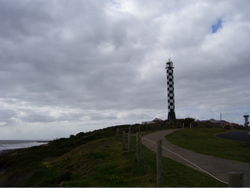Bunbury, Western Australia
| Bunbury Western Australia |
|
 Panorama of Bunbury from lookout Tower |
|
 Bunbury
|
|
| Population: | 66,117 (2009)[1] (27th) |
| • Density: | 396/km² (1,025.6/sq mi) |
| Established: | 1836 |
| Area: | 138.7 km² (53.6 sq mi) |
| Time zone: | AWST (UTC+8) |
| Location: | |
| Region: | South West |
| State District: |
|
| Federal Division: | Forrest |
The port city of Bunbury is the third largest city in Western Australia after the State Capital Perth and Mandurah. It is situated 175 kilometres (109 mi) south of Perth's central business district (CBD). The port services the farming and timber industries of the south west originally connect via an extensive rail network.
Bunbury was the birth place of Western Australia's first Premier and explorer John Forrest.
Contents |
Geography
Bunbury is situated 175 kilometres south of Perth, near the mouth of the Collie River at the southern end of the Leschenault Inlet, which opens to Koombana Bay and the larger Geographe Bay which extends southwards to Cape Naturaliste.
History
The first registered sighting of Bunbury was by French explorer Captain Louis de Freycinet from his ship the Casuarina in 1803. He named the area Port Leschenault after the expedition's botanist, Leschenault de la Tour. The bay was named Geographe after another ship in the fleet.
In 1829, Dr Alexander Collie and Lieutenant Preston explored the area of Bunbury on land. Later Lieutenant Governor Sir James Stirling visited the area and a military post was established. The area was renamed Bunbury by the Governor in recognition of Lieutenant Henry William St. Pierre Bunbury (1812–75), who developed the very difficult inland route from Pinjarra to Bunbury.[2]
Rail transport
The Pinjarra to Picton Junction railway line was completed in 1893, connecting Bunbury to Perth, and also to the coal and mineral deposits and agricultural areas to the north and east. The famous railway roundhouse and marshalling yards located at what is now Bunbury Centrepoint shopping centre were a vital service centre for the steam engines of the day. The train station served as the terminal for the longest lasting named service in Western Australia - the Australind passenger train between Perth, transporting its first passengers on 24 November 1947 and connecting to a newly established bus network distributing passengers all over the South West.
By 1983, the railway into the city (closely following Blair Street's alignment) was considered an eyesore by the local council and developers, who wished to take advantage of the newly elected Burke Labor government's pledges to make Bunbury an alternative city to Perth. A new station was constructed at Wollaston 4 km to the southeast, and the last train to use the old station departed Bunbury on 28 May 1985 with the new terminal commencing operations the following day. The railway land was then sold and Blair Street realigned. The Australind passenger service was then substantially upgraded in 1987.
At present there are two departures and two arrivals at Wollaston every day of the week. The former train station is now the Bunbury Visitor Centre and is the main bus station for Bunbury City Transit services. It is also a stop for Transwa and South West Coach Lines bus services.
Bunbury Historical Society's King Cottage Museum
King Cottage was built around 1880 by Henry King and was owned by his family until 1923 when it was sold to the Carlson family. In 1966 it was purchased by the City of Bunbury and subsequently leased to the Bunbury Historical Society. The rooms of the cottage are furnished to fit the period from the 1880s to the 1920s. The artifacts displayed are part of the Society's collection reflecting the way of life for a family in Bunbury during that period.[3]
Lord Forrest

The first Baron Forrest of Bunbury,(Lord Forrest) was to be the title bestowed on Bunbury born John Forrest, who was the first Premier of Western Australia, explorer and surveyor of Western Australia. Leading three expeditions the first in search of Ludwig Leichhardt, two expeditions to Adelaide the first surveying the route of Edward John Eyre across the Nullarbor Plain, the second from Geraldton to the overland telegraph line between Adelaide and Darwin in search of pastoral land in the interior of Western Australia.[4][5]
In 1890 when Western Australia gained rite to self rule from Britain, Forrest was elected unopposed to the seat of Bunbury in the Legislative Council and was appointed as the first Premier of Western Australia. Forrest government embarked on a large scale public works expansion under the direction of engineer C. Y. O'Connor including the building of Fremantle harbour and the Goldfields Water Supply Scheme. On the 13th February 1901 Forrest resigned as Premier of Western Australia and member for Bunbury so he could contest the seat of Swan in the first federal election. On 29 March 1901 Forrest was elected to first Australian Parliament where he remained until he resigned due to cancer in March 1918.[4][5]
On 6 February 1918, Forrest was informed that he was to be raised to the British peerage as Baron Forrest of Bunbury in the Commonwealth of Australia and of Forret in Fife in the United Kingdom. Forrest died 2 September 1918 while travelling to London, to receive treatment and hoping to take his seat in the House of Lords. However no Letters patent were issued before his death, so the peerage was not officially created. According to Rubinstein (1991), "his peerage is not mentioned or included in Burke's Peerage, The New Extinct Peerage, the Complete Peerage, or any other standard reference work on the subject."[4][5]
Transport
Transwa provides rail and coach services: Australind train, GS3, SW1 and SW2 to Bunbury and services south from Bunbury and South West Coach Lines provides coach services to and from Bunbury. Town services are run by Bunbury City Transit with 11 routes.
Description

The local government of the City of Bunbury has a population of 32,499. Bunbury has sister-city relationships with Setagaya, Japan, and Jiaxing, China. In 2007 Bunbury was recognised as Australia's fastest growing city for 2005/06 period by the Australian Bureau of Statistics (ABS).[6][7] Bunbury's climate is similar to that of Western Australia's capital Perth.
| Bunbury | |
|---|---|
 Bunbury's lighthouse and Marlston Hill's lookout tower |
|
| Location: | Western Australia |
| Height: | meters |
| Focal Height: | Metres |
| Intensity: | cd |
| Range: | nautical miles |
The Bunbury Tower, often called the "Milk Carton" for its distinctive shape and blue-and-white colours, is the major feature of the city centre's skyline. It was built in 1983 by businessman Alan Bond. Also prominent are the old lighthouse and lookout tower in the Marlston Hill district, which has been a focus of the city's cultural and commercial growth since the late 1990s.
Bunbury is the home of the Golden West Network, a regional television network broadcasting to the state of Western Australia. GWN had its origins in Bunbury as Channel 3 in the late 1960s, and then purchased other stations from Kalgoorlie and Geraldton, as well as launching a satellite service in 1986 to form the current network. Bunbury houses the network headquarters and production facilities, with the Channel 3 transmitter located at Mount Lennard approximately 25 km to the east.
Regional television station WIN can also be received in Bunbury. WIN Television maintains an office and news bureau, however the station itself is based in Perth.
Recently a new hotel residential complex was built overlooking the estuary. The foundations and main building are built upon an old grain silo.
On 11 November 2008, Bunbury-Jiaxing Business Office was established to boost business opportunities between the two regions by assisting with communications and facilitating trade. The office is currently operated by Chenxi (Edwin) Zhuang, who is born and raised in Jiaxing and came to Australia to study his Bachelor of Business degree.
Suburbs
|
|
Media
Radio
AM band
- 6EL 621 kHz AM - Easy Listening format. Different to its Easy Listening Network partners in the Eastern states. Has local advertising. Will soon become part of The Spirit Network.
- ABC South West WA (6BS): 684 kHz AM - News, talk and sport. Broadcasts breakfast and morning programs from Bunbury.
- RadioWest 963 kHz AM - Adult Contemporary for the 40+, with news feeds and sport from 6PR in Perth. Mostly 60s, 70s, & 80s (which in turn is part of the LocalWorks network).
- Vision Radio Network 1017 AM - Christian praise and worship music and talk.
- 6MM 1116 kHz AM- Easy Listening Format from Mandurah
- ABC Radio National 1224 kHz AM - Speciality talk and music.
FM band
- ABC Classic FM 93.3 MHz FM - Classical music.
- Triple J 94.1 MHz FM - Alternative music.
- Hot FM 95.7 MHz FM - Hit Music.
- 96.5 Harvey Community Radio
- 97.3 Coast FM
Television
Television services available include
- The Australian Broadcasting Corporation (ABC) - ABC1, ABC2, ABC3, ABC News 24 (digital channels)
- The Special Broadcasting Service (SBS) - SBS One, SBS Two (digital channels)
- WIN Television, a dual affiliate station of both the Nine Network and Network Ten.
- GWN Television (Golden West Network), an affiliate station of the Seven Network.
Both GWN and WIN provide local news services from Monday to Friday . GWN News screens at 5.30pm before Seven News Perth. WIN News screens at 6.30pm following Nine News Perth.
The programming schedule is mainly the same as the Seven, Nine and Ten sations in Perth with variations for News buletins, sport telecasts such as the Australian Football League and National Rugby League, childrens and lifestyle programs and infomercials or paid programming.
New Digital television services from GWN and WIN are expected to launch by the end of 2010, including a new channel branded Ten West, a stand alone Network Ten affiliated channel.
Subscrition Television service Foxtel is available via Satellite.
Newspapers
Bunbury Herald, South Western Times and Bunbury Mail are local newspapers available in Bunbury and surrounding region.
Newspapers from Perth including The West Australian and The Sunday Times are also available, as well as National Newspaers such as The Australian and The Australian Financial Review.
Notable people from Bunbury
- Paul Barnard, AFL footballer for Essendon Football Club, played in 2000 Premiership [8]
- Murray Goodwin, Zimbabwe, Western Australia and Sussex cricketer [9]
- John Forrest, First Premier of Western Australia and cabinet minister in Australia's first parliament
- Troy Elder, Australian field hockey player
- Natalie Barr, current Sunrise news presenter
- Barry Shepherd, Australian cricketer
- Aristos Papandroulakis, television Surprise Chef
- Sara-Marie Fedele, popular Australian Big Brother 1 housemate
- Leon Baker, AFL footballer for Essendon Football Club, played in 1984 and 1985 Premierships [10]
- Adam Hunter, West Coast Eagles AFL player [11]
- Bob Maumill, 882 6PR radio presenter
- Mark Worthington, South Dragons NBL Player
- Kyle Reimers, Essendon Football Club AFL Player
- Neville Jetta, Melbourne Football Club AFL Player
- Jamie Bennell, Melbourne Football Club AFL Player
Climate
Bunbury has a Mediterranean climate (Köppen classification Csb) with warm summers and mild winters.
| Climate data for Bunbury, Western Australia | |||||||||||||
|---|---|---|---|---|---|---|---|---|---|---|---|---|---|
| Month | Jan | Feb | Mar | Apr | May | Jun | Jul | Aug | Sep | Oct | Nov | Dec | Year |
| Average high °C (°F) | 29.2 (84.6) |
29.8 (85.6) |
27.6 (81.7) |
23.9 (75) |
21.0 (69.8) |
18.4 (65.1) |
17.3 (63.1) |
17.3 (63.1) |
18.3 (64.9) |
20.6 (69.1) |
24.2 (75.6) |
27.0 (80.6) |
22.9 (73.2) |
| Average low °C (°F) | 15.0 (59) |
15.6 (60.1) |
14.1 (57.4) |
11.6 (52.9) |
9.6 (49.3) |
8.1 (46.6) |
7.2 (45) |
7.5 (45.5) |
8.5 (47.3) |
9.1 (48.4) |
12.0 (53.6) |
13.4 (56.1) |
11.0 (51.8) |
| Precipitation mm (inches) | 11.0 (0.433) |
6.2 (0.244) |
16.8 (0.661) |
37.2 (1.465) |
98.2 (3.866) |
147.9 (5.823) |
151.2 (5.953) |
123.5 (4.862) |
79.5 (3.13) |
35.2 (1.386) |
20.9 (0.823) |
16.8 (0.661) |
737.9 (29.051) |
| Source: [12] | |||||||||||||
See also
- Bunbury Regional Prison
- Bunbury City Transit
- City of Bunbury
Photo gallery
 View west of the harbour from the lookout tower, August 2007 |
 View north of the harbour from the lookout tower, August 2007 |
 Wheat silos converted to residential apartments |
References
- ↑ Australian Bureau of Statistics (30 March 2010). "Regional Population Growth, Australia, 2008–09` - Western Australia". http://www.abs.gov.au/ausstats/[email protected]/Products/3218.0~2008-09~Main+Features~Western+Australia?OpenDocument. Retrieved 2 April 2010.
- ↑ Reed, A.W. (1973) Place Names of Australia, p. 48 Sydney, NSW: A.H & A.W.Reed, ISBN 0 589 07115 7
- ↑ "Bunbury Historical Society, King Cottage Museum". Bunbury Historical Society. http://www.bunburyhistorical.org/. Retrieved 2008-11-21.
- ↑ 4.0 4.1 4.2 Serle, Percival (1949). "FORREST, SIR JOHN, first Baron Forrest of Bunbury (1847-1918),". Dictionary of Australian Biography. Project Gutenberg Australia. http://gutenberg.net.au/dictbiog/0-dict-biogF.html#forrest3. Retrieved 2008-11-21.
- ↑ 5.0 5.1 5.2 F. K. Crowley (1981). "Forrest, Sir John [Baron Forrest (1847 - 1918)"]. Australian Dictionary of Biography. Australian National University. http://www.adb.online.anu.edu.au/biogs/A080565b.htm. Retrieved 2008-11-20.
- ↑ 3218.0 Regional Population Growth, Australia. Australian Beureau of Statistics. February 27, 2007.
- ↑ "3218.0 Regional Population Growth, Australia", produced by the ABS on 27 February 2007.
- ↑ Genine Unsworth, ABC South West WA, "Export: Paul Barnard", June 12, 2002. Accessed 2 October 2007.
- ↑ John Ward, Cricinfo, "Murray Goodwin - a short biography", September 20, 1999. Accessed 2 October 2007.
- ↑ "Essendon Football club - Leon Baker Profile". 2008. http://www.essendonfc.com.au/history/profile.asp?ID=1. Retrieved 2008-06-03.
- ↑ "West Coast Eagles Football club - Player Profile - Adam Hunter". 2008. http://www.westcoasteagles.com.au/TheClub/Players/PlayerProfile/tabid/7302/Default.aspx?playerid=14570&typeid=2. Retrieved 2008-06-03.
- ↑ "Climate statistics for Bunbury". Australian Bureau of Meterology. http://www.bom.gov.au/climate/averages/tables/cw_009965.shtml.
External links
- City of Bunbury website
- Bunbury Historical Society's King Cottage Museum
- Local History of Bunbury
- Bunbury Port Authority
|
||||||||||||||||||||||||||
|
||||||||||||||
|
||||||||